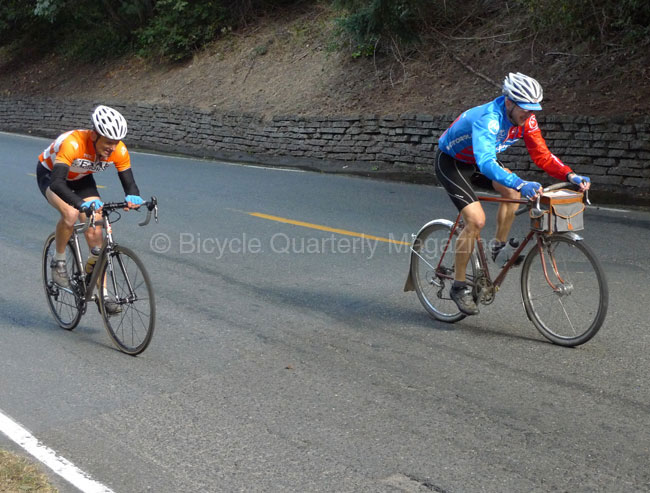What is Planing?

Can a 650B randonneur bike climb as well as the best titanium racing bikes? It did climb as well in a Bicycle Quarterly test, and that raised a few eyebrows. After all, the randonneur bike weighed 10 pounds more…
Theoretically, assuming equal power output on each bike, the lighter bike will be faster up the hill. So how could the heavier randonneur bike keep up?
The assumption of “equal power output” lies at the root of many misunderstandings about bicycle performance. A rider’s power output varies with many factors, like fatigue and comfort. One factor often has been overlooked: How well the bike’s frame gets in sync with the rider’s pedal strokes also affects how much power the rider can put out.
On different bikes, the same rider will have different power outputs. Optimize the bike’s flex characteristics, and your rider will be able to put out more power.

First, let’s look at how much that weight difference really amounts to. For a rider who weighs 165 pounds and a bike that weighs 15 pounds, adding 10 pounds increases the weight of rider-and-bike by 5%. To keep up with the titanium racing bike, the rider on the randonneur bike has to put out about 4% more power. Is that feasible?

The answer is yes.
A few years ago, we did a double-blind test. Jeff Lyon built four frames for us. They were identical, except for minor variations in frame tubing (and hence frame stiffness). The differences were small – just 0.2 mm difference in the wall thicknesses of top and down tubes (Bike 2), or 1/8″ in the diameter (Bike 3). Bike 4 was a duplicate of Bike 1, as an additional check of our results. Apart from those two frame tubes, all four bikes were absolutely identical – same tubes, same geometry, same paint, same components. Even the same weight: The lighter frames had weights inside to equalize the weight.
The goal of this experiment was simple: We wanted to see whether small differences in frame tubing are discernible to the riders, and whether they make a measurable difference in performance. Would our riders prefer the stiffest bike? Or the most flexible? Or would it make no difference at all?
The test was a true double-blind test. Neither test riders nor test administrator knew which frame was made from which tubing. To hide the tubing diameter (one frame used oversized tubing), the bikes were wrapped in foam insulation. In every way, the test met the most rigorous scientific standards.
We rode the bikes in a variety of tests. One of them was an uphill sprint for 340 m (1100 ft), with two testers racing each other. Both bikes were equipped with calibrated power meters. We repeated the sprints five times, with the riders switching bikes after each run. After the fifth run, the riders were exhausted, so we stopped the experiment. It’s one of half a dozen experiments that all showed the same: Small differences in frame tubing can lead to a significantly different feel and performance.

The results for one rider were especially clear (above). Despite starting the experiment on Bike 1, the rider consistently put out more power on Bike 2 than on Bike 1. The rider was also consistently faster on Bike 2. The inferior performance of Bike 1 wasn’t for a lack of trying – nobody likes to get dropped! In fact, the rider’s “effort” and “perceived exertion” were greater on Bike 1. In other words, the rider was working harder, yet putting out less power. (The low power output for Run 5 simply shows that the rider is exhausted…)
The difference in power output was about 12%. That is huge, and it shows that the frame’s tubing, and how it interacts with the rider’s pedal strokes, affects how fast a bike climbs – more than almost anything else (except the rider’s fitness).
To give this phenomenon a name, we called it “planing” – like a boat that rises out of the water and requires less energy to go at higher speed than it did fully submerged at lower speeds.

Back to the comparison between the randonneur bike and the titanium racing bike: Yes, it does weigh 10 pounds more, but we now know that a difference in power output of about 4% is well within the range of possibilities. And that extra power can compensate the heavier weight of the randonneur bike, making both bikes climb at the same speed.
How does it all work? Read about it in the next post about the biomechanics of “planing.”
Further reading:
- Information about Bicycle Quarterly, the magazine that did this research.
- The full story of the double-blind experiment: Bicycle Quarterly 24.
- More double-blind tests, including power data, and a physiological explanation how “planing” works: Bicycle Quarterly 28.
- Titanium shoot-out: Bicycle Quarterly 42.
Thank you to all who made the original research possible: Jeff Lyon built the test frames; Hahn Rossman assembled them and administered the test; Mark Vande Kamp and Alex Wetmore volunteered as testers.


